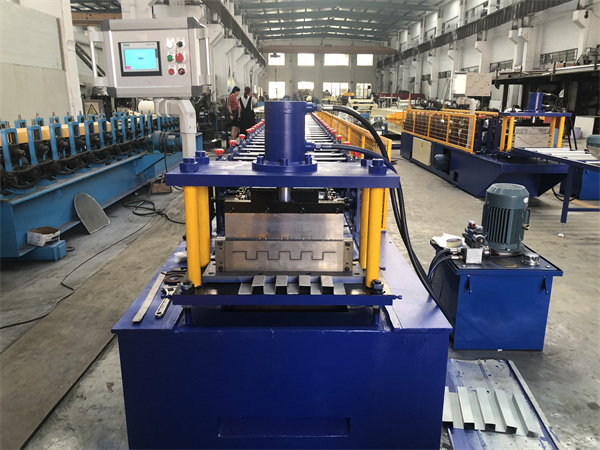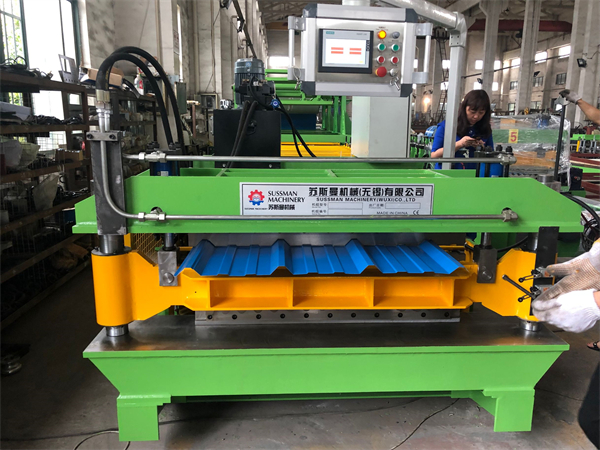Roll forming is a metal forming process used to convert flat metal sheets into curved or other profiled cross-sections. Portable roll forming machines provide an efficient and flexible solution for roll forming at the construction site or in the field. This comprehensive guide covers key aspects of portable roll forming machines from types, technical specifications, applications, installation, operation and maintenance.
Overview of Portable Roll Forming Machines
Portable roll forming machines are designed to be easily transported and operated at job sites for on-demand production of various profiles directly from coil stock. Key advantages include:
- Flexible forming capability for wide range of profiles including roofing panels, wall panels, C-channels, structural studs etc.
- Compact design for portability and minimal space requirement at site
- Quick set-up and easy operation compared to fixed in-plant roll forming lines
- Lower investment cost suitable for small to mid-size production volumes
- On-site forming reduces logistics cost of transporting pre-formed sections
Portable roll forming machines typically have 3-12 forming stations. More stations allow longer product length and more complex profiles.
Main Types of Portable Roll Forming Machines
| Type | Description |
|---|---|
| C-Portable | Compact and lightweight design, typically 3-5 roll stations. Well suited for small forming jobs. Lower productivity than other types. |
| H-Portable | Heavier capacity machines with up to 8 stations for metal sheets up to 1.5 mm thickness. Better for long panels and structural sections. |
| U-Portable | U-shaped frame houses up to 12 roll stations. Advanced portable solution capable of complex, high-precision forming. |
Key Specifications of Portable Roll Formers
Main technical parameters when selecting portable roll forming equipment:
| Specification | Typical Range |
|---|---|
| Forming Width | 500 – 1300 mm |
| Forming Thickness | 0.3 – 1.5 mm |
| Forming Speed | 3 – 15 m/min |
| Forming Stations | 3 – 12 stands |
| Main Drive Power | 3 – 15 kW |
| Machine Weight | 500 – 4000 kg |
Lighter weight and more compact footprint maximize portability. Higher speed and power allow greater output. More roll stations enable longer profiles and more forming steps.
Typical Applications of Portable Roll Forming
On-site roll forming with portable machines is advantageous for:
- Roofing – Standing seam, corrugated, tile, etc.
- Wall panels – Insulated, structural, architectural, etc.
- Silo and tank sheets
- Drainage channels and eave gutters
- Steel door frames
- Special architectural profiles
- C-channels, angles, structural studs
- Special industrial shapes
- Sheet metal ducting
Portable roll forming is cost-effective for short to medium production runs in the above applications.

Portable Roll Former Operation
How Does a Portable Roll Former Work?
A portable roll forming machine feeds metal coil stock through a series of stations each with a pair of forming rolls. The rolls progressively shape the sheet in small increments as it passes through the machine.
Key components of a portable roll former:
- Coil Payoff Reel – Holds coil stock
- Feed Table – Feeds stock into first forming station
- Forming Stations – Typically 3 to 12 stands to achieve profile
- Hydraulic System – Applies pressure on rolls for forming
- Cutoff Knife – Cuts formed profiles to length
- Controller – Controls line speed, cut lengths, etc.
The forming stations mount on a frame with wheels for mobility. Guide rolls properly align the strip through each station.
Portable Roll Former Design
Portable roll forming machine frames have a straight inline design or U-shape configuration.
Inline Frame: Stations are in a straight line allowing sheet to pass through. Well suited for long parts like roofing panels. Limited on profile shape.
U-Frame: Forming stands position on sides of a U-shaped frame. Strip follows a U path. Allows more forming on each side and complex profiles.
Other components like decoilers, hydraulic unit, control panel, and cutting table are designed for mobility. Locking casters, lifting points, and forklift channels enable easy transport between sites.
How to Operate a Portable Roll Former
Typical operation process:
- Set-up – Lock roll former in position. Install proper tooling in stations for desired profile. Thread coil through stands.
- Forming – Adjust settings like speed, pressure, cut length. Start line to feed metal sheet through roll stations. scrap pieces until forming is calibrated.
- Cut-off – Cut formed profiles to length at cutoff station.
- Material Handling – Manually offload or automatically stack finished parts.
- Transport – Move machine to new location or store it.
Proper operating practices maximize output quality and efficiency. Keep rolls clean and lubricated. Monitor strip tension and alignment. Use precision linear measuring for cut lengths.
Selecting Portable Roll Forming Equipment
How to choose the right portable roll forming machine? Key factors:
Metal Sheet Properties
- Thickness – Thinner sheets under 0.5 mm need fewer stations. Over 1 mm requires heavy-duty machine.
- Width – Narrower coils need smaller width capacity.
- Strength – Softer material like aluminum forms easier than high-tensile steel.
- Coating – Painted/coated stock may need larger roll diameters.
Matching machine capacity to sheet properties ensures proper forming.
Product Shape and Size
- Profile type – More complex shapes need U-frame versus inline.
- Section length – Long panels over 6 m need more stations.
- Dimensional accuracy – Tighter precision requires more stations.
The machine must have enough stations and runs to achieve the desired part configuration.
Production Volume
- Short run – Compact C-portable units are ideal for small lot sizes.
- Medium volume – Full-size portable lines are designed for up to ~5000 tons per year.
- High volume – Fixed in-plant roll mills are better for over 5000 tons per year.
Portable roll formers are most economical at production volumes between 100-5000 tons per year.
Portable Roll Former Suppliers
There are many equipment manufacturers offering portable roll formers. Some major international suppliers include:
| Company | Location |
|---|---|
| Bradbury Group | US |
| Formtek Group | US |
| Shanghai Metal Corporation | China |
| Gasparini S.p.A | Italy |
| FactoryCo | South Africa |
Domestic suppliers should also be evaluated based on local presence and service support.
Purchase Cost Considerations
| Specs | Cost Impact |
|---|---|
| Capacity | Higher capacity increases cost |
| Frame Type | U-frame costs more than inline |
| Stations | More roll stands increase price |
| Automation | Automated versus manual material handling affects price |
| Brand Reputation | Premium brands command higher pricing |
Typical price range is $50,000 to $500,000 based on the above factors. Renting or buying used equipment can reduce initial investment.

Installation and Maintenance
Proper installation and maintenance ensures optimum performance and longer service life of a portable roll forming machine.
Installation Best Practices
- Position on flat, level surface and anchor or bolt down frame
- Provide adequate space around for safe material loading/unloading
- Use precision instruments to align roll stations and ensure proper setup
- Electrical connections should be 3-phase power supply through a control panel
- Integrate with upstream coil handling and downstream stacking/bundling as needed
Maintenance Schedule
| Activity | Frequency |
|---|---|
| Inspect roll condition | Daily |
| Check strip alignment | Daily |
| Lubricate bearings | Weekly |
| Verify hydraulic pressure | Monthly |
| Change hydraulic oil | Yearly or per hours of operation |
| Inspect/replace damaged rolls | As needed |
| Calibrate/align roll stations | As needed |
Daily cleaning and visual inspection identifies potential issues early. Proactive maintenance reduces unplanned downtime and improves productivity.
Supplier Selection Criteria
How to select the best portable roll forming equipment supplier?
- Technical expertise in roll forming, including design experience and process knowledge
- Solution customization capability based on application requirements
- Machinery quality in terms of durability, precision, and reliability
- Training and support for installation, operation, maintenance, and troubleshooting
- Local presence for sales and after-sales service
- Delivery time and flexibility
- Reasonable pricing providing value for money spent
- Company reputation and experience in the industry
Choosing an established company with expertise ensures a high-quality portable roll forming solution.
Advantages of Portable Roll Forming
Key benefits of using portable roll forming equipment:
- On-site production reduces logistics cost of moving pre-fabricated metal parts
- Flexibility to make different profiles at changing job sites
- Faster project turnaround by avoiding long lead times of offsite fabrication
- Lower investment than large in-plant roll forming mills
- Space savings with compact footprint suitable for tight areas
- Customization possible by adjusting roll tooling for new shapes
- Efficiency through automated coiling, forming and cutting
- Cost-effectiveness for short to medium production volumes
The biggest advantage of portable roll formers is the ability to make parts on demand at the point of use.
Limitations of Portable Roll Forming
Despite the benefits, portable roll forming has some limitations:
- Lower productivity compared to high-speed in-plant roll form lines
- Limited profile capability based on machine capacity and stations
- Repeatability may be lower than fixed roll form mills
- Operator skill required for proper setup and operation
- Size and weight constraints for easy portability
- Outdoor use can expose equipment to weather elements
- Coil handling logistics must be managed
- Higher per unit cost than dedicated mass production roll forming
Within these constraints, portable roll formers provide an efficient forming solution for onsite production requirements.

FAQ
What profiles can portable roll formers make?
Typical profiles include roofing panels, wall panels, drainage channels, silo sheets, structural studs, door frames, solar frame parts, and various open shapes like C, Z, hat, and U channels.
What metal thickness is possible?
Standard portable roll forming machines can process metal sheet between 0.3 mm to 1.5 mm thickness. Extended capacity models are available for over 2 mm thick material.
How long are the parts made by portable roll formers?
Formed part lengths up to 12 meters are possible with bigger machines having 6 or more forming stations. Typical lengths range from 3-6 meters for roofing panels and wall cladding applications.
How much does a portable roll forming machine cost?
Cost depends on capacity and features. Compact C-type machines start around $50,000. Full-size portable roll formers with multiple stations cost $150,000 to $500,000.
What safety precautions are needed?
Use proper guarding around the pinch points. Ensure convenient emergency stop buttons. Provide safety training on material handling and cutoff operation. Enforce use of protective gear by operators.
How much space is needed for a portable roll former?
A small portable roll former may fit in a space about 4 m x 3 m. Large models require around 10 m x 4 m area. Sufficient clearance must be provided all around for safe operation.
What is the difference between portable and fixed roll forming?
Fixed roll form mills have much higher production capacity but lack portability. Portable roll formers sacrifice some speed for the flexibility to produce profiles on-site as required.
How to choose rolls and tooling for profile shapes?
Work with your roll form machine supplier to specify the correct progressive tooling based on product shape, material gauge, widths, etc. Proper tooling design ensures quality forming.
What maintenance is required?
Daily cleaning and lubrication. Periodic inspection of roll wear, strip alignment, hydraulics. Yearly oil changes. Proactive maintenance improves performance and reduces downtime.
